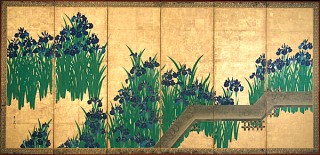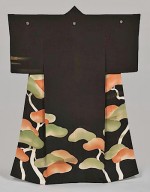Column Name
Title

Ogata Korin, Irises at Yatsuhashi (1709-1716), six-panel folding screen with ink and color on gilt paper, 70 1/2 in. x 12 ft. 2 1/4 in.
(Photo by Metropolitan Museum of Art)“Designing Nature: the Rinpa Aesthetic in Japanese Art,” a colorfully quirky, uneven, but ultimately triumphant show, is on view at the Metropolitan Museum of Art through January 13.
Body
The clever pun that gives the exhibition its title can mean that nature itself is a master of design or that the Japanese artists, loosely grouped as the Rinpa (also called Rimpa) school, made designs based on nature. It also refers to the “artifice of the design” of the work these artists produced. The term Rinpa itself is hard to define precisely. Rinpa technically means the school of Ogata Korin, a 17th-century painter from Kyoto, but it also broadly refers to a style of arts and artifacts going back to Korin and his contemporaries and continuing up to modern times.
What is especially fascinating for me as a specialist in Western art is that the origin of Rinpa in 17th-century Kyoto was in many ways parallel to the Italian Renaissance about a century earlier. In both cases the artists were independent, had large workshops, and produced work for rich merchants; Rinpa subject matter hearkens back to imagery from the Heian Court (794-1185), just as the Italian Renaissance referred to Classical art of Greece and Rome. It was revived numerous times in 18th- and 19th-century art and also paralleled neo-Classical movements in the West. Rinpa artists specialized not only in painting, but also pottery, lacquerware, cloth, kimonos, books, poetry, and calligraphy.
The rich Met exhibition includes major examples of all of these. Mostly taken from the museum’s own holdings, it is supplemented by about 45 loans from public and private collections. I saw the first of two installments, which was changed in early September; although the second part contains many new pieces, some of the works will remain up for the entire time.
The objects showcased here epitomize the genre of Japanese art that became emblematic of Japan once it opened to the West in 1867. It had a huge influence on European artists—especially French Impressionists and Post-Impressionists—toward the end of the 19th and beginning of the 20th centuries. Rinpa took Paris by storm during the 1890s, and drew Gauguin and Van Gogh to the south of France (which Van Gogh called “his Japan”). The Art Nouveau movement also derived a great deal from Rinpa as this exhibit shows.
I must say that I found the organization of the exhibition quite puzzling. The first gallery is dominated by a piece called PixCell-Deer#24 by Kohei Nawa (born 1975). He made this taxidermied deer with artificial crystal glass in 2011. It is true that deer imagery held religious and poetic significance and was among imagery depicted by Rinpa artists, but one wonders what Korin would think of this placement. I also question the prominent position at the start of the show of a large bamboo object made in the 1990s called “Renewal” (Ishin) from the Waves series by Monden Kogyoku (born 1916).
Only toward the end of the exhibit do we get to see a large screen by Ogata Korin (1658–1716) called Cranes, Pines, and Bamboo, one of the works by the master from whom the name Rinpa derives. In it, a decorative stream flows toward the viewer; roots and branches of trees and stones made from varied ornamental strokes echo the calligraphic lines of the cranes that enclose negative spaces. These auspicious symbols of long life—cranes, pines, and bamboo—are also the subject matter of many other Rinpa works.
A pair of six-panel folding screens from the Edo period (1615-1868) depict spring and autumn grasses next to a stream. Done with ink, color, gold, and silver on paper, they look to me like music as it unfolds over time. Swirling black ink lines on white unpainted paper meander from upper right to left, across, down, and back up, looking for all the world like a musical staff accompanied by colorful blossoming trees and leaves. In the spring screen, there are azaleas, white blossoms, and a glimpse of pink cherry blossoms; in the autumn screen, brown magnolias and golden ginkgo and maple leaves show the passage of time. The color green accompanies it all like a basso continuo, and the Met describes the screens as a chromatic symphony. Though the artist is unknown, curators note that certain stylistic qualities suggest followers of Ogata Korin.
A quite different, very simple, two-panel screen by Sakai Hoitsu (1761-1828) is The Persimmon Tree (1816), which depicts just one crooked, fragile tree with bent branches and only a few clustered red fruits. It was on view only through early September. As it happens, the Japan Society has an exhibition entirely devoted to Hoitsu (who became a Buddhist monk) that runs through January 6 (visit japansociety.org for details).
Many kimonos and obis (sashes), as well as ceramic works and lacquerware appear towards the end of the exhibit. Among them was the gorgeous Summer Robe With Waves and Cormorant Fishing (1925-50)—an incredible Art Nouveau robe that unfortunately is no longer on view. But one that will be is the Obi With Stylized Waves from the Meiji period (1868–1912), made of silk and metallic-thread double cloth (futsu). The incredible crashing waves frozen in motion decorating this sash resemble Korin’s iconic screen Rough Waves, which was part of the first rotation, as well as the equally iconic Hokusai woodcut Great Wave Off Kanagawa (1830-33).
Waves, so important to the island nation of Japan, appear throughout the exhibit in trees, stones, branches, real and mythical animals (claws, fangs, tails, manes), as well as in calligraphy.
Two screens that I didn’t see since they are part of the second rotation are Korin’s celebrated Irises at Yatsuhashi (after 1709), with its dazzling gold background, and a pure calligraphic one from the early 17th century by Konoe Nobutada. The latter work, on public display for the first time, features transcriptions of poems by female poets from the Heian court.
The Rinpa aesthetic as displayed at the Met gives us an ample opportunity to study the myriad forms, symbols, lines, and shapes that make up the essence of Japanese art.





